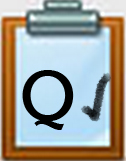Q2 That Didn't Work. Now What? Vocabulary
Key Vocabulary
Application: An application is software designed to perform specific tasks or functions.
Flowchart: A flowchart is a step-by-step diagram with symbols.
Frozen: When a computer or application is frozen, it is unresponsive and not working properly.
Hardware: Hardware refers to the physical parts of a computer.
Software: Software is a program that runs on a computer.
Solve: To solve is to find the answer.
Troubleshoot: Troubleshoot is to identify and fix problems.
Competencies & Standards
MITECS Michigan Integrated Technology Competencies for Students, and
1. Empowered Learner
a. Articulate and set personal learning goals, developing strategies leveraging technology to achieve them, and reflect on the learning process itself to improve learning outcomes
c. Use technology to seek feedback that informs and improves their practice and to demonstrate their learning in a variety of ways
d. Understand the fundamental concepts of technology operations, demonstrate the ability to choose, use and troubleshoot current technologies, are able to transfer their knowledge to explore emerging technologies
5. Computational Thinker
c. Break problems into component parts, extract key information and develop descriptive models to understand complex systems or facilitate problem solving
6. Creative Communicator
a. Choose the appropriate platforms and tools for meeting the desired objectives of their creation or communication
c. Communicate complex ideas clearly and effectively by creating or using a variety of digital objects such as visualizations, models or simulations
Websites and Documents
21t4s Videos
21t4s Websites
21t4s Documents & Quizzes




